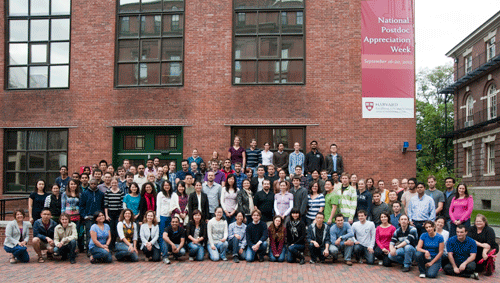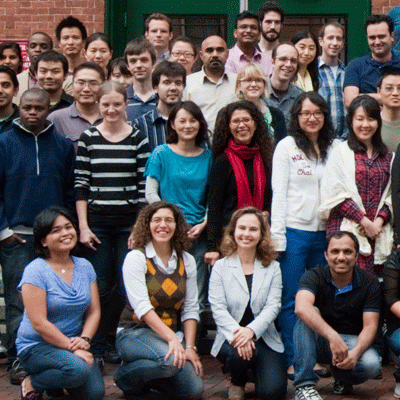News
Postdoctoral fellows in the Harvard Faculty of Arts and Sciences gather during National Postdoc Appreciation Week. (Photo by Jon Chase.)
Postdoctoral researchers, immersed in theoretical and experimental studies, contribute immeasurably to the life and work of the university. Yet to some extent they are a hidden community—no longer the student, not yet the teacher—bursting with a culture and lifestyle of their own.
Those working with Leslie Valiant, T. Jefferson Coolidge Professor of Computer Science and Applied Mathematics, enjoy group trips to the sushi buffet. Others relish the travel, perhaps attending a summertime conference in Hawaii.
If you ask computer scientist Alexander Lex, however, “The best part is to work a new idea on the whiteboard.”
That’s understandable given the potential impact of Lex’s ideas, which could improve the ways we think about, diagnose, and treat illnesses such as cancer. His research aims to create new visualization tools to help scientists and medical clinicians analyze complex data—for example, genomic information that, interpreted correctly, could suggest a personalized treatment. He works with Hanspeter Pfister, An Wang Professor of Computer Science.
Lex came to the United States from Austria, where research and teaching responsibilities were allocated somewhat differently within each faculty member’s group. Now he finds himself helping other Austrians navigate that same transition into American academic life.
Within the School of Engineering and Applied Sciences (SEAS) alone, the postdocs hail from 32 different nations—Azerbaijan to the United Kingdom.
Electrical engineer Vivek Venkataraman came to the United States from India in 2006, earned his Ph.D. at Cornell University, and arrived at Harvard a year ago. Working with Marko Loncar, Tiantsai Lin Professor of Electrical Engineering, Venkataraman explores diamond as a material for building future computing, sensing, and measurement devices.
“There is a vibrant international community in the universities here, and I have had the privilege of interacting with people from diverse backgrounds,” Venkataraman says, adding that ping-pong tournaments in the LISE building are a common diversion for researchers craving social time. “It has been an enlightening experience.”
He ultimately hopes to return to India and pursue a career in teaching and science writing.
“In a postdoc position, you’re at the start of your science or engineering career,” says Cherry A. Murray, dean of SEAS, John A. and Elizabeth S. Armstrong Professor of Engineering and Applied Sciences, and professor of physics. “You can focus almost exclusively on doing spectacular research without competing demands on your time to manage a lab, raise money, or be on the tenure track.”
Academic leaders at SEAS and in the Faculty of Arts and Sciences' Office of Postdoctoral Affairs offer advising, mentoring, CV review sessions, opportunities for training, and networking events—and a newly formed postdoctoral advisory council is helping expand those offerings at SEAS.
“Supporting the postdocs, a community of researchers so important to our School’s mission, is a priority for our dean and for me and the Office for Academic Affairs as well,” says Edward J. Kleifgen, senior associate dean for faculty affairs and student services.

Postdoctoral researchers in the Faculty of Arts and Sciences gathered for an ice cream social during National Postdoc Appreciation Week. (Photo by Jon Chase.)
September 16–20 is National Postdoc Appreciation Week, and Harvard has been celebrating the occasion with an ice cream social, free massage sessions, and a barbecue, organized by the FAS Office of Postdoctoral Affairs, as well as a special reception hosted by SEAS—not to mention ongoing career fairs and recruiting events.
After all, the postdocs’ post-Harvard aspirations are as diverse as their research projects.
Brendan Juba, for instance, who studies the computational abilities of multi-agent systems, wants to continue to develop and grow his research. Others, like Peter Nguyen, are already thinking about the applications.
Nguyen, who works with Neel Joshi, assistant professor of chemical and biological engineering, aims to “harness bacteria as biological factories to make designer biomaterials."
“Think of how birds weave nests, spiders spin webs, and bees construct hives. Bacteria do something similar: they secrete a self-made cloak of sugars, DNA, and proteins,” he explains. “I’m trying to develop ways for us to use [these] biofilms as a green biomaterial, much in the same way we use tree tissue (wood) for structures, and caterpillar secretions (silk) for textiles.”
He hopes to eventually commercialize his findings as the core technology of a start-up company. For now, however, he’s enjoying the unconstrained freedom of his postdoctoral position.
“You have minimal managerial responsibilities and spend most of your time pushing ideas and projects forward in the lab. You’re experienced enough to move fast on experiments, troubleshoot instantly, and plug yourself into the scientific network,” Nguyen says. “It’s the best time of your life, I think, to do stellar science.”
Cutting-edge science delivered direct to your inbox.
Join the Harvard SEAS mailing list.
